Art and Culture
15 Protest Artworks That Went Too Far
Marvel at the boundary-pushing protest artworks that sparked outrage and debate, leaving a lasting impact on artistic expression.
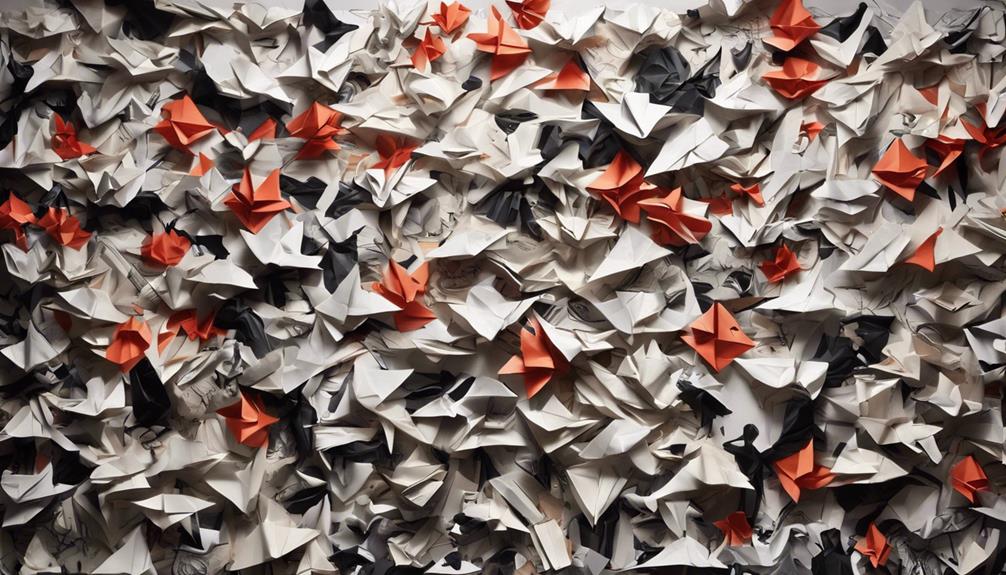
In particular, protest artworks are recognized for challenging societal norms and sparking debate. However, some instances have overstepped boundaries, testing the limits of artistic expression and provocation. Examples include the Byzantine Iconoclasm (726-787; 814-842), Suffragette targeting Velázquez's Rokeby Venus (1914), Rauschenberg's erasure of a De Kooning (1953), the vandalism of The Pieta with a hammer (1972), and the Mona Lisa being spray-painted on tour (1974). Particularly, in 1996, an art student infamously vomited on masterpieces. Dollar Sign on Malevich Abstraction (1997), Chinese artists recreating Tracey Emin's 'My Bed' (1999), and the Taliban's destruction of the Bamiyan Buddhas (2001) further exemplify controversial protest artworks.
Key Takeaways
- Vandalism of iconic artworks like the Mona Lisa and Night Watch sparked outrage.
- Destruction of religious icons during Byzantine Iconoclasm challenged societal norms.
- Suffragette's attack on the Rokeby Venus highlighted art as a tool for activism.
- Erasure of a De Kooning piece by Rauschenberg pushed boundaries of art creation.
- Damage to the Pietà and Guernica raised concerns on mental health and art activism limits.
The Byzantine Iconoclasm (726-787; 814-842)
During the Byzantine Iconoclasm of 726-787 and 814-842, Emperor Leo III the Isaurian issued edicts to destroy religious icons. This period marked a significant turning point in Byzantine history, as the empire saw a deliberate effort to eradicate religious imagery from various forms of art.
The Iconoclasm, driven by a desire to consolidate power and establish theological purity, led to the destruction of many artworks depicting religious figures, including mosaics and sculptures. Successive emperors continued these measures, resulting in widespread damage to cultural and religious artifacts.
The Iconoclasm created division within the Byzantine Empire, with tensions running high between iconoclasts and iconophiles who revered religious icons. This tumultuous period not only altered the artistic landscape of the empire but also had lasting implications on religious practices and beliefs.
The legacy of the Byzantine Iconoclasm serves as a reminder of the complex interplay between art, politics, and religion in shaping historical events.
Suffragette Targets Velázquez's Rokeby Venus (1914)
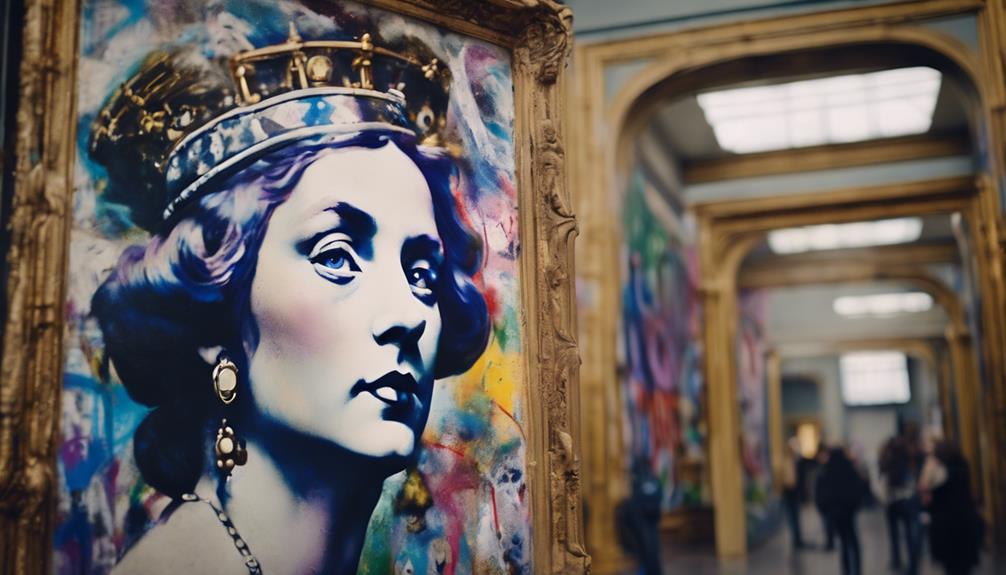
The suffragette movement made a bold statement in 1914 when Mary Richardson targeted Velázquez's Rokeby Venus with a slashing attack. This act was part of the suffragist movement's strategy to use vandalism as a form of protest for women's rights.
Mary Richardson believed that by destroying the painting, she could bring attention to the cause of women's suffrage and the need for gender equality in society. The attack on Velázquez's Rokeby Venus sparked debates on the ethics of using art vandalism as a means of political activism, highlighting the intersection of art, activism, and women's rights in the early 20th century.
- Mary Richardson's targeting of Velázquez's Rokeby Venus was a deliberate and calculated act aimed at drawing attention to the suffragette cause.
- The suffragette movement viewed art vandalism as a powerful tool to amplify their message and provoke societal change.
- Richardson's actions raised important questions about the boundaries of protest and the role of art in advocating for social justice.
Rauschenberg Erases a De Kooning (1953)
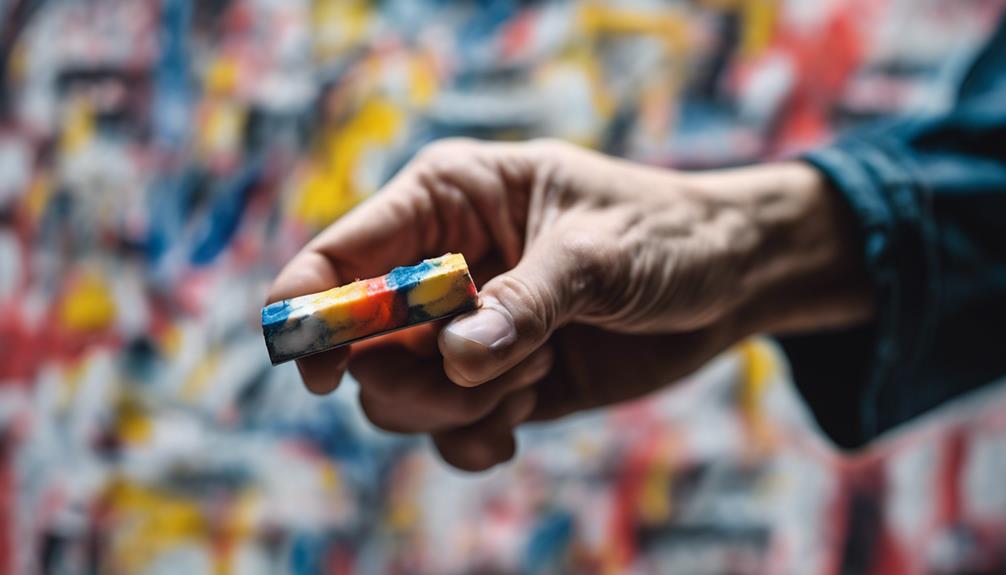
Robert Rauschenberg's erasure of Willem de Kooning's drawing in 1953 stirred debate over whether it was an artistic statement or an act of vandalism.
The impact of this bold move reverberated through the art world, challenging conventional ideas of authorship and boundaries.
Ethical considerations about the erasure's implications on art's value and the artist's role were raised, sparking discussions that continue to resonate in contemporary art discourse.
Artistic Statement or Vandalism?
Erasing Willem de Kooning's drawing in 1953, Robert Rauschenberg sparked debates on the nature of art. Some viewed Rauschenberg's act as a bold artistic statement challenging traditional norms, while others condemned it as vandalism crossing the boundaries of art.
Here are three key points to mull over:
- Artistic Statement: Rauschenberg's erasure of de Kooning's drawing was intended to make a profound statement about the nature of art itself. By removing the work of another renowned artist, Rauschenberg questioned the traditional notions of authorship, ownership, and the value of artistic creation.
- Vandalism: Critics of Rauschenberg's action labeled it as vandalism, arguing that destroying a piece of art, even with artistic intent, was a disrespectful act that undermined the value and integrity of de Kooning's original work.
- Boundaries of Art: The erasure of de Kooning's drawing forced viewers to confront the boundaries of art, pushing them to reconsider what constitutes art and how far artists can go in challenging established conventions. Rauschenberg's controversial act continues to prompt discussions on the limits of artistic expression and the role of destruction in the creative process.
Impact on Art World
Rauschenberg's erasure of de Kooning's drawing in 1953 left a lasting impact on the art world, challenging traditional notions of authorship and sparking debates on artistic boundaries.
By erasing a significant work by de Kooning, Rauschenberg made a bold protest against established norms, questioning the very essence of art creation. This act of erasure wasn't merely an act of vandalism but a deliberate statement that pushed the boundaries of what art could be.
The erased de Kooning piece became a symbol of defiance and controversy, drawing attention to the power of artistic gestures to provoke thought and challenge the status quo. Rauschenberg's bold move forced the art world to reconsider the value and permanence of artworks, igniting discussions that continue to resonate in contemporary art discourse.
This protest artwork demonstrated the transformative impact that art can have in challenging perceptions and reshaping artistic conventions.
Ethical Considerations Raised
The erasure of Willem de Kooning's drawing by artist Robert Rauschenberg in 1953 stirred ethical debates within the art world.
Three key ethical considerations raised by Rauschenberg's act of erasing a fellow artist's work include:
- Destruction of Art: Rauschenberg's erasure of de Kooning's drawing challenged the conventional idea of art preservation, prompting discussions on whether destroying an artwork could itself be considered a form of artistic expression.
- Ethical Considerations: The deliberate erasure of a renowned artist's work raised questions about the ethical implications of altering or obliterating someone else's creation, questioning the boundaries of artistic freedom and respect for the original artist's intentions.
- Artist's Work: The erasure also brought to the forefront debates about authorship and the value attributed to an artist's work, challenging traditional notions of ownership and creativity in the art world.
The Pietà Hit With a Hammer (1972)

An assailant caused significant damage to Michelangelo's 'The Pietà' in 1972 by attacking it with a hammer in St. Peter's Basilica. The hammer-wielding individual targeted the sculpture's face and arm, leading to substantial harm.
It was later revealed that the attacker, believed to be mentally disturbed, was swiftly apprehended by alert bystanders and subsequently placed under institutional care. The aftermath necessitated an extensive restoration process lasting several months, requiring intricate reconstruction of the impacted sections to restore the artwork's integrity.
This distressing event prompted discussions on the importance of mental health care and raised concerns about the security measures within art institutions. The incident not only highlighted the vulnerability of priceless artworks to such acts but also underscored the significance of addressing mental health challenges within society.
The lasting impact of this incident serves as a poignant reminder of the intersection between art, mental well-being, and the need for enhanced security protocols in safeguarding cultural treasures.
Mona Lisa Spray-Painted on Tour (1974)
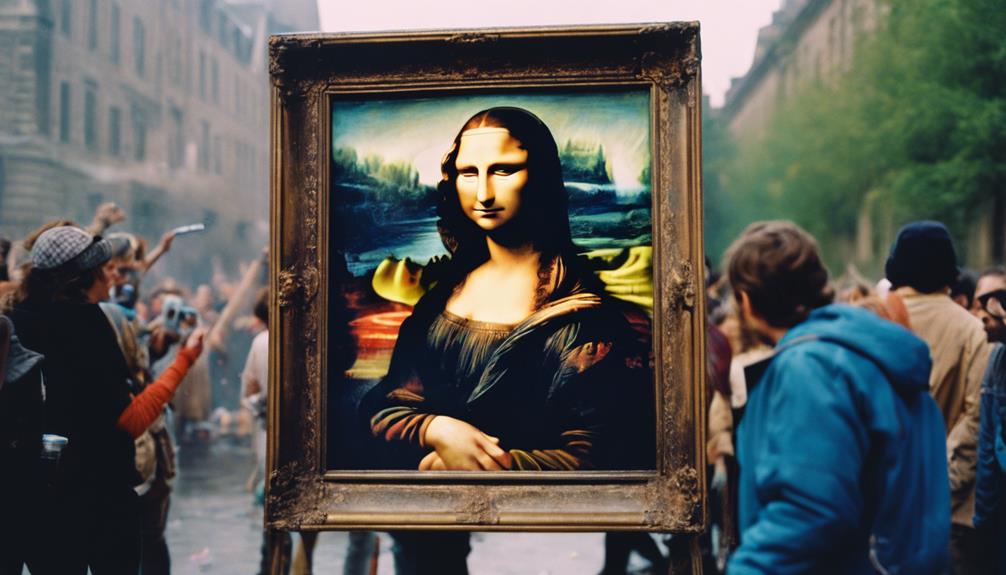
During a tour in 1974, the Mona Lisa encountered an act of vandalism through spray-painting, leading to damage and heightened security measures. The incident sparked concern over the vulnerability of iconic artworks to such attacks.
- The spray-painting of the Mona Lisa in 1974 shocked the art world, highlighting the risks faced by famous pieces during public exhibitions.
- Security protocols were notably enhanced following this vandalism, with increased surveillance and protective measures deployed to safeguard valuable artworks.
- The swift apprehension of the individual responsible for the spray-painting incident underscored the severity of such offenses and the importance of maintaining strict security around renowned artworks.
The spray-painting of the Mona Lisa serves as a stark reminder of the challenges faced by priceless artworks during public displays, prompting museums and galleries to prioritize security measures to prevent future incidents of vandalism.
Art Dealer Protests With Picasso's Guernica (1974)

In 1974, an art dealer utilized Picasso's renowned painting Guernica as a potent tool in protesting the Spanish government's policies.
This act not only sparked debates on the intersection of art, politics, and activism but also underscored the significant role of art as a means for social and political commentary.
The use of Guernica in this protest highlighted the enduring impact and power of Picasso's masterpiece as a vehicle for conveying powerful statements.
Picasso's Powerful Statement
Picasso's Guernica made a powerful statement when an art dealer protested by throwing ink at the iconic painting in 1974. This act of protest using one of Picasso's most renowned works sparked significant discussions within the art world.
Here are three key points to ponder:
- Symbolism of Guernica: Guernica, originally created by Picasso in response to the bombing of the Basque town during the Spanish Civil War, is a powerful anti-war symbol. The use of this particular artwork intensified the impact of the protest, emphasizing the message of peace and protest against violence.
- Challenging the Art Market: The protest aimed to draw attention to the frustrations of the art dealer regarding the commercialization of art. By targeting Guernica, the dealer highlighted the tension between art as a form of expression and art as a commodity within the market.
- Debate on Protest Art: This incident ignited debates on the boundaries of protest art and the effectiveness of controversial actions in conveying social or political messages. The protest with Guernica raised questions about the role of art in society and the power it holds in sparking dialogue and change.
Impact of Artivism
Throwing ink at Picasso's Guernica during an auction in 1974, the art dealer made a bold statement against the exploitation of art for profit and political gain. This act of artivism aimed to draw attention to the powerful anti-war message portrayed in the iconic painting.
However, the protest quickly turned into art vandalism, sparking debates on the boundaries of protest within the art world. The incident raised questions about the impact of such extreme actions on political statements and the consequences of damaging significant works of art.
The art dealer, after being swiftly apprehended, faced legal repercussions for defacing the renowned artwork. The event highlighted the fine line between using art as a form of protest and crossing into vandalism, shedding light on the complexities and controversies surrounding artivism.
Ultimately, the protest with Guernica serves as a cautionary tale regarding the consequences of pushing artistic activism to its limits.
Rembrandt's Night Watch Slashed (1975)
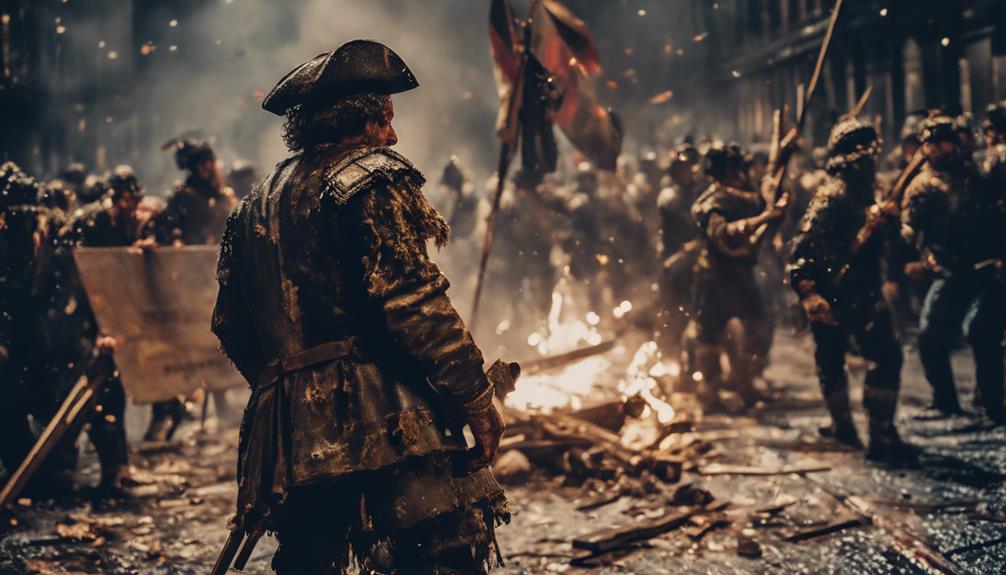
The obscure deity's messenger inflicted significant damage on Rembrandt's Night Watch painting in 1975 by slashing it in Amsterdam. This act of vandalism shocked the art world and raised concerns about the security and preservation of valuable masterpieces in public spaces.
Three key points regarding the slashing of Rembrandt's Night Watch are:
- Targeted Attack: The attacker specifically targeted Rembrandt's Night Watch, a renowned masterpiece, with the intent to cause harm and destruction.
- Divine Mission Claim: The perpetrator claimed to be on a divine mission, adding a mysterious and unsettling aspect to the incident.
- Restoration Efforts: Following the vandalism, extensive restoration efforts were undertaken to repair the slashed sections of the painting, highlighting the importance of preserving cultural heritage and the resilience of the art community in the face of such acts of destruction.
Hammons Whizzes on a Serra Sculpture (1981)

In a provocative challenge to the art world's conventions, artist David Hammons made a bold statement by urinating on a Richard Serra sculpture titled 'T.W.U.' at Leo Castelli Gallery in New York in 1981. Hammons' act was a deliberate attempt to confront the commercialization of art and ignite conversations about race and class within the art sphere. This controversial performance at the renowned gallery sent shockwaves through the art community, questioning the boundaries of artistic expression and the elitism prevalent in the art world.
To emphasize the impact of this event, a comparison between David Hammons and Richard Serra can be made:
| David Hammons | Richard Serra |
|---|---|
| Challenged conventions | Renowned sculptor |
| Provocative statement | Established reputation |
| Critique on art world | Traditional artistic norms |
| Controversial act | Monumental sculptures |
| Sparked debates | Critically acclaimed |
Danaë Splashed With Smelly Liquid (1985)

Mary Beth Edelson, a feminist artist, made a bold statement in 1985 by splashing a mixture of cow dung and urine on the Danaë painting at the Art Institute of Chicago.
The act was a form of protest against patriarchal attitudes in art:
- Edelson intended to challenge the traditional portrayal of women as passive objects for the male gaze.
- The protest aimed to disrupt the prevailing gender representations in art that perpetuated objectification and subordination of women.
The protest sparked discussions on feminist art and gender representation:
- By targeting a classic painting like Danaë, Edelson highlighted the need to reexamine historical artworks through a feminist lens.
- The incident raised questions about the role of art in shaping societal norms and promoting gender equality.
The controversial act was a deliberate attempt to provoke dialogue on power dynamics:
- Edelson's protest sought to confront viewers with the discomfort of confronting entrenched patriarchal norms within the art world.
- The incident emphasized the importance of challenging established conventions to foster inclusivity and diverse perspectives in art.
Hammons' Public Artwork Struck (1989)
Amidst the vibrant streets of Harlem, New York City in 1989, David Hammons' public artwork depicting a basketball hoop faced an unexpected collision with a car. The installation, known as 'Higher Goals', was a part of Hammons' artistic exploration of social and racial issues.
The deliberate act of vandalism on this public artwork was interpreted as a commentary on the struggles experienced by marginalized communities. Hammons, known for his unconventional approach to exploring themes of race, identity, and urban culture, often pushes the boundaries of traditional art forms.
The incident sparked discussions regarding the intersection of protest art and vandalism, raising questions about the impact of such actions on artistic expression. Despite the unexpected turn of events, Hammons' work continues to provoke thought and challenge societal norms through his unique artistic vision, making a lasting impact on the art community in Harlem and beyond.
Duchamp's Urinal Takes the Piss (1993)

Duchamp's controversial artwork 'Fountain', a urinal displayed as art in 1917, stirred debates challenging traditional notions of artistic value. The piece, created by Marcel Duchamp, sparked controversy due to its unconventional nature and defiance of traditional artistic norms.
Here are three key points to ponder regarding Duchamp's 'Fountain':
- Challenging Conventions: Duchamp's 'Fountain' pushed boundaries by questioning the very definition of art, leading to discussions about what can be viewed as artistic expression.
- Conceptual Impact: The urinal raised profound questions about the role of the artist and the nature of originality in art, influencing the development of conceptual art.
- Critical Reception: While some critics viewed 'Fountain' as a bold and thought-provoking statement, others found it obscene and struggled to accept it as a legitimate artwork.
Duchamp's 'Fountain' remains a controversial and seminal work in the history of art, leaving a lasting impact on the art world's perception of what constitutes art.
Art Student Vomits on Masterpieces (1996)

In 1996, an art student named Marco Evaristti deliberately vomited on masterpieces displayed at a Danish museum, causing a significant uproar in the art world. Evaristti, as a form of protest art, consumed red cabbage soup laced with a potent emetic before regurgitating onto the artworks, titling his controversial performance art piece 'Helena.'
This shocking act ignited debates regarding the boundaries of art and the preservation of cultural heritage, questioning the extent to which artistic expression should be allowed to challenge societal norms. Evaristti's actions were met with legal consequences and widespread public backlash due to the blatant disrespect shown towards the invaluable masterpieces.
The incident serves as a stark reminder of the fine line between artistic expression and vandalism, highlighting the need for artists to approach protest art with sensitivity and respect for the cultural significance of the objects they interact with.
Dollar Sign on Malevich Abstraction (1997)
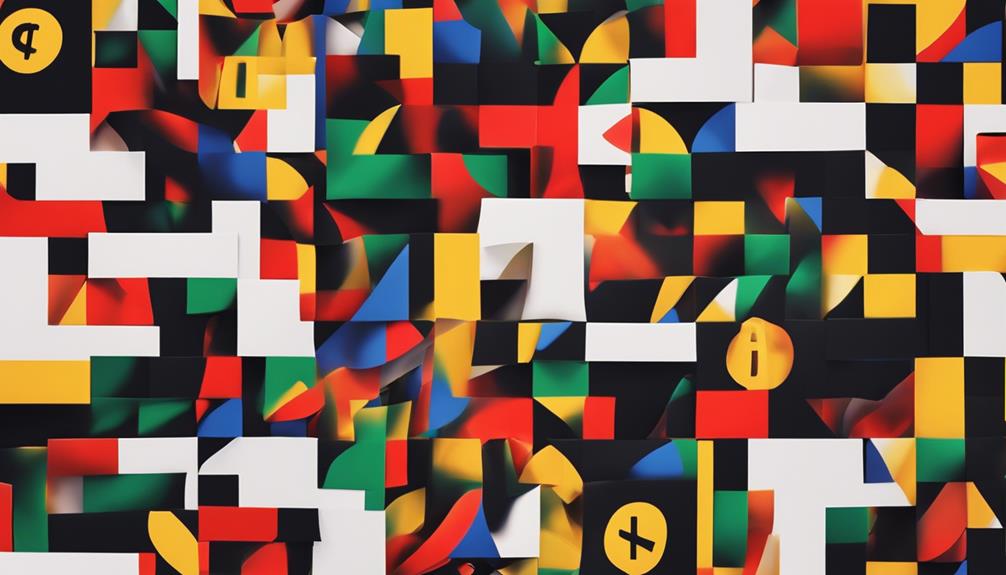
An unknown artist's decision to spray-paint a dollar sign on Kazimir Malevich's Black Square in 1997 sparked controversy within the art community. The defacement of this iconic piece at the Stedelijk Museum in Amsterdam raised questions about the boundaries of artistic expression and the impact of symbolism in protest art.
Critics and enthusiasts alike were divided on whether this act challenged capitalism's influence on art or disrespected a revered masterpiece.
Controversial Symbolism Choice
The controversial protest artwork from 1997 featured a bold dollar sign painted onto a reproduction of Malevich's iconic abstract painting. This choice of symbolism aimed to challenge societal norms and provoke thought on the commercialization of art. The use of the dollar sign sparked debates on the intersection of art, money, and symbolism.
The protest aimed to critique the commercialization of art and challenge societal values associated with wealth and power.
The provocative choice of symbol on the artwork aimed to provoke thought and challenge traditional notions of artistic expression.
This controversial protest artwork highlighted the artist's intention to make a statement on the commodification of art in modern society.
Impact on Art Community
The controversial protest artwork 'Dollar Sign on Malevich Abstraction' by Andrei Molodkin ignited discussions within the art community regarding the impact of commercialization on artistic expression. Molodkin's piece, created in 1997, features a dollar sign painted on a reproduction of Kazimir Malevich's iconic abstract painting, 'Black Square.'
By critiquing the commercialization of art and the influence of money on artistic expression, the artwork challenges viewers to reconsider the value and integrity of art in a capitalist society. The juxtaposition of the dollar sign on Malevich's work sparked debates about the intersection of art, commerce, and social commentary within the art community.
This protest piece raised important questions about how monetary interests may affect the purity and authenticity of artistic creation, prompting artists and critics to reflect on the balance between artistic integrity and financial pressures in the modern art world.
Chinese Artists Jump on Tracey Emin's Bed (1999)

Chinese artists boldly recreated Tracey Emin's controversial artwork 'My Bed' in 1999, sparking intense debates about cultural boundaries and artistic expression.
The Chinese version of the artwork featured a messy bed adorned with condoms, cigarettes, and alcohol bottles, aiming to challenge Western art norms and ignite discussions about cultural differences.
This provocative piece was exhibited in a Beijing gallery, where it triggered heated debates regarding the limits of artistic freedom and the interpretation of cultural symbolism.
The controversial recreation by the Chinese artists was perceived as a daring statement on the dynamics of cultural exchange and the diverse perspectives on artistic representation.
Taliban Destroy the Bamiyan Buddhas (2001)
The Taliban's destruction of the Bamiyan Buddhas in 2001 had a profound impact on cultural heritage. These statues held immense historical significance dating back to the 6th century. Situated in the Bamiyan Valley, a UNESCO World Heritage Site, the Buddhas represented a unique blend of art and history that was irreversibly lost due to the Taliban's actions.
This act of iconoclasm highlighted the clash between differing interpretations of religious beliefs and led to widespread global condemnation of the Taliban's disregard for cultural preservation.
Historical Significance of Buddhas
Destroying the Bamiyan Buddhas in 2001 by the Taliban sparked global outrage due to the statues' historical significance and UNESCO World Heritage status. The Bamiyan Buddhas were monumental ancient statues located in Afghanistan, standing at heights of 53 meters and 35 meters.
These cultural treasures, dating back to the 6th century, were recognized as UNESCO World Heritage sites, representing a significant part of Afghanistan's rich history and religious heritage. The destruction of the Bamiyan Buddhas not only erased physical artifacts but also symbolized a deliberate attack on cultural heritage and religious tolerance, resonating globally and bringing attention to the impact of political ideologies on historical artifacts.
The event served as a stark reminder of the importance of preserving and protecting cultural heritage sites for future generations, highlighting the need for increased awareness and safeguarding of such invaluable treasures.
Impact on Cultural Heritage
Regrettably, the Taliban's destruction of the Bamiyan Buddhas in 2001 had a profound and lasting impact on cultural heritage worldwide. The ancient giant statues, dating back to the 6th century, were significant cultural and religious symbols.
The act of destroying these Buddhas as a form of protest not only erased a tangible piece of history but also highlighted the dangers extremist ideologies pose to heritage sites. The international outrage that followed underscored the need to protect cultural treasures during times of conflict and political unrest.
Efforts to rebuild or restore the Buddhas have been met with challenges due to the extensive damage caused. This tragic event raised important questions about the preservation and safeguarding of cultural heritage, emphasizing the delicate balance between expressing dissent and respecting the rich history that these sites represent.
The legacy of the Bamiyan Buddhas serves as a stark reminder of the irreplaceable loss that can occur when heritage is targeted for destruction in the name of protest.
Frequently Asked Questions
What Famous Painting Was Destroyed by an Activist?
An activist, Mary Richardson, destroyed The Rokeby Venus by Velázquez in 1914 at the National Gallery in London.
Richardson's act of vandalism aimed to protest women's rights as part of the suffragette movement.
The painting was later restored, but the incident remains a notable example of art vandalism for a political cause.
What Is the Most Controversial Form of Art?
The most controversial form of art varies depending on perspective. Some may find performance art pushing boundaries with extreme audience interactions, while others may see provocative conceptual art challenging traditional norms as the most contentious.
Controversy can also stem from political commentary in art, feminist pieces with bold statements, or works that challenge religious sensitivities. Ultimately, what's considered the most controversial form of art is subjective and open to interpretation.
Which Famous Art Works Were Vandalised Recently?
Recently, a group of activists from Just Stop Oil vandalized Van Gogh's 'Sunflowers' at London's National Gallery with tomato soup. They also glued their hands to the wall under the painting.
Despite being arrested, the activists pleaded not guilty to causing damage. District judge Tan Ikram released them on bail with specific conditions.
Charges have been pressed on protestors in the past for similar art vandalism actions.
Which 20TH Century Artwork Was so Controversial That Congress Argued About It?
In the 20th century, the controversial artwork that sparked Congressional debates was Andres Serrano's 'Piss Christ.' This photograph depicted a crucifix submerged in the artist's urine, igniting discussions on art, religion, and freedom of expression.
The contentious nature of 'Piss Christ' led to debates on government funding for provocative art, highlighting the intersection of artistic expression and public sensibilities.
The artwork's controversy underscored the complex dynamics between art, religion, and societal norms.
Conclusion
To sum up, these protest artworks push the boundaries of artistic expression, challenging societal norms and sparking important conversations. While some may view them as going too far, they serve as powerful reminders of the impact art can have on the world.
By pushing the limits of acceptability, these artists force us to confront uncomfortable truths and question our own beliefs. As we continue to navigate the complex landscape of art and activism, it's essential to recognize the profound influence these provocative works can have.
Art and Culture
Cutting-Edge Art Techniques Emerging in the Indian Art Scene
Keen insights into the dynamic fusion of tradition and innovation in Indian art reveal exciting possibilities; discover how these techniques are reshaping creative expression.

You're witnessing a vibrant transformation in the Indian art scene as artists merge traditional techniques with cutting-edge innovations, redefining creative expression. Digital art, augmented reality, and interactive installations are gaining traction, allowing for immersive audience experiences. Artists like Bharti Kher and Jitish Kallat reinterpret age-old practices within contemporary contexts. Alongside this, online galleries and social media are enhancing the visibility of emerging talents. The fusion of traditional elements with modern themes is addressing important social issues too. Stick around to discover how these trends shape the future of Indian art and create new avenues for artistic exploration.
Key Takeaways
- Artists are integrating augmented reality and AI to create immersive and interactive art experiences, redefining viewer engagement.
- Digital art techniques, such as algorithmic art and digital collages, are addressing contemporary themes and expanding artistic expression.
- Collaborations between artists and international galleries foster innovative projects, blending cultural narratives and enhancing the visibility of diverse artistic practices.
- Emerging artists are utilizing street art to tackle social and political issues, merging traditional techniques with modern themes for impactful storytelling.
- Online platforms and virtual exhibitions have revolutionized art accessibility, connecting Indian artists with global audiences and promoting their work beyond physical galleries.
Traditional Art Foundations
Exploring traditional Indian art forms reveals a rich tapestry woven from the country's diverse cultural and spiritual heritage.
These traditional art practices, rooted in historical eras like the Indus Valley civilization, Buddhism, Jainism, and Islam, showcase the essence of India's identity. Techniques such as miniature painting, Kalamkari, Warli, and Madhubani not only reflect the historical context but also emphasize the spiritual themes prevalent in the artworks, offering a glimpse into the diverse beliefs that shape the nation.
Additionally, contemporary artists are increasingly drawing inspiration from these traditional forms, leading to innovative interpretations that resonate with current societal themes, such as the beauty found in imperfections seen in stain art.
You'll notice that traditional art often utilizes natural materials like clay, wood, and stone, highlighting the deep connection to nature that exists within Indian culture.
The intricate patterns and vivid colors in these traditional art forms are an indication of the skill and dedication of the artists. As you explore these vibrant creations, you'll see how they serve as a source of inspiration for modern artists, who are increasingly reinterpreting these age-old techniques.
Modern Artistic Innovations

In today's art scene, you're witnessing a remarkable shift as artists blend digital advancements with traditional techniques.
The integration of technology is reminiscent of how AI and music creation is transforming creative processes, allowing for innovative collaborations that push boundaries.
Interactive installations are becoming a focal point, inviting you to engage with art in ways you've never experienced before.
As fusion techniques emerge, the boundaries of creativity are expanding, revealing new dimensions in artistic expression.
Digital Art Advancements
As technology evolves, digital art in India is experiencing a remarkable transformation, with artists harnessing innovative tools to push creative boundaries. Contemporary artists are leveraging techniques like algorithmic art and digital collages to explore themes that resonate with modern society; AI in Cybersecurity can also enhance creative processes by providing data-driven insights. This shift not only reflects personal narratives but also broader cultural dialogues.
The rise of online art galleries and social media platforms has notably enhanced the visibility of Indian digital artists, allowing them to showcase their work to a global audience. As a result, collaborations are flourishing, paving the way for exciting new projects that blend diverse artistic visions.
Moreover, augmented reality (AR) is redefining the viewer experience, creating interactive installations that invite engagement. Venues like The Designera pop art gallery exemplify how AR can transform traditional art appreciation into immersive journeys.
The pandemic played an essential role, accelerating the adoption of digital platforms for art creation and sales. Virtual exhibitions became the norm, enabling artists and galleries to connect with audiences despite lockdowns.
Educational institutions are also embracing this trend, incorporating digital art techniques into their curricula, nurturing a new generation of artists who blend tradition with technology.
Interactive Installations Unveiled
The rise of digital art has paved the way for an exciting trend in the Indian art scene: interactive installations. These installations engage you through immersive experiences that blend technology with traditional art forms.
At exhibitions like the India Art Fair 2023, you'll encounter remarkable interactive pieces, such as Debashish Paul's performance art that investigates queer identity, showcasing social themes while inviting your participation. This innovative approach mirrors the therapeutic benefits found in practices like essential oils for relaxation, enhancing emotional well-being while inviting creative expression.
Artists like Sudarshan Shetty and Shrimanti Saha are leading the charge with their public projects, encouraging audience involvement and prompting reflection on contemporary issues. The integration of augmented reality in these installations transforms your interaction with art, making it more innovative and enriching.
This technology not only enhances your understanding of the artwork but also deepens your connection to the themes presented. Interactive installations are redefining how you experience art, expanding the dialogue surrounding inclusivity and community engagement.
In contemporary Indian culture, these works invite you to become active participants rather than passive observers, fostering a richer relationship with the art and its messages. As you explore these dynamic installations, you'll find that they resonate on multiple levels, making art more accessible and relevant to your everyday life.
Fusion Techniques Explored
Fusion techniques are transforming the landscape of contemporary Indian art, where artists blend traditional styles like Madhubani and Warli with modern methods. This innovative fusion of traditional and contemporary practices resonates with both local and global audiences and often reflects deeper psychological themes, akin to the dynamics observed in narcissistic relationships.
Take Bharti Kher, for example; her work incorporates bindis into modern installations, showcasing how traditional elements can be reinterpreted in fresh contexts.
Emerging artists are also pushing boundaries by using mixed media, combining painting, sculpture, and digital art. This approach enhances visual storytelling and challenges conventional norms.
Jitish Kallat's "Covering Letter" exemplifies this trend by juxtaposing historical narratives with modern materials, bridging the gap between past and present.
Contemporary galleries are increasingly showcasing these dynamic works, fostering a vibrant dialogue within the Indian art scene. This encourages exploration and experimentation, allowing emerging artists to carve their unique paths.
As you engage with this evolving landscape, you'll find that the fusion techniques not only revitalize traditional art forms but also invite you to experience a richer, more engaging narrative that celebrates India's diverse cultural heritage.
Blending Old and New Techniques

A vibrant dialogue between tradition and modernity defines contemporary Indian art, where artists skillfully blend age-old techniques with innovative approaches. You'll see how contemporary Indian artists are merging traditional forms like miniature painting and Madhubani with modern styles, creating works that resonate with both historical significance and contemporary themes.
The fusion of ancient art with modern technology illustrates this dynamic conversation. For instance, Bharti Kher's installations using bindis exemplify this blend, while Jitish Kallat juxtaposes traditional letters with contemporary materials, crafting compelling narratives. This blending of old and new techniques revitalizes interest in traditional art forms, making them relevant in today's context.
| Traditional Techniques | Modern Techniques | Notable Artists |
|---|---|---|
| Miniature Painting | Digital Installations | Bharti Kher |
| Madhubani Art | Mixed Media Collages | Jitish Kallat |
| Warli Art | Abstract Expressionism | Various Contemporary Artists |
| Tanjore Painting | Conceptual Art | Emerging Talents |
This growing popularity of hybrid forms showcases how blending traditional and modern not only enhances cultural exchange but also contributes uniquely to the global art scene.
Cultural Relevance of Traditional Art

Traditional Indian art forms like Madhubani and Warli carry deep cultural significance, reflecting the country's rich heritage and spiritual beliefs. These traditional art styles utilize natural materials and intricate patterns, showcasing craftsmanship that's been passed down through generations.
They're not just visually stunning; they embody the narratives and values of various communities. As these art forms evolve, they also promote celebrating family bonds and shared experiences, enhancing their cultural relevance.
You'll notice contemporary artists increasingly integrating traditional techniques into their modern works. This fusion revitalizes interest and guarantees that these age-old practices remain relevant in today's art landscape. By doing so, they preserve the essence of Indian cultural heritage while adapting it to contemporary themes.
The preservation and evolution of traditional art are essential for maintaining India's cultural identity. As you explore these art forms, you'll gain insights into historical narratives and social values that have shaped the nation.
Additionally, Indian art galleries play an important role in promoting traditional art, offering platforms for emerging artists to showcase their unique interpretations and engage with global audiences.
In this way, traditional art continues to resonate, bridging the past with the present and guaranteeing that the richness of India's cultural heritage is celebrated and preserved for future generations.
Impact of Art Galleries

Art galleries greatly shape the contemporary art landscape in India, acting as essential platforms for artists to showcase their work. They play a pivotal role in promoting contemporary artists by providing spaces that celebrate diverse styles and genres.
Additionally, these galleries often reflect broader economic trends, much like how gold prices have shown resilience during economic downturns, highlighting the importance of stability in both art and finance.
Here's how art galleries impact the Indian art scene:
- They connect artists, critics, and collectors, fostering valuable relationships.
- Exhibitions blend traditional and modern art forms, allowing innovation within cultural heritage.
- Prominent galleries like Vadehra Art Gallery and Gallery Espace spotlight both established and emerging talents.
- They host international artists, promoting cultural exchange and enhancing global dialogue.
- By facilitating sales, art galleries contribute to the economic sustainability of artists.
These galleries are more than just exhibition spaces; they're vibrant hubs that nurture the growth of Indian art.
By showcasing contemporary artists, they help elevate the visibility of local talent on a global stage. Your engagement with art galleries not only enriches your appreciation for Indian art but also supports the artists and their journey.
Essentially, art galleries are fundamental to the evolving narrative of contemporary art in India, bridging the gap between tradition and modernity.
Digital Transformation in Art
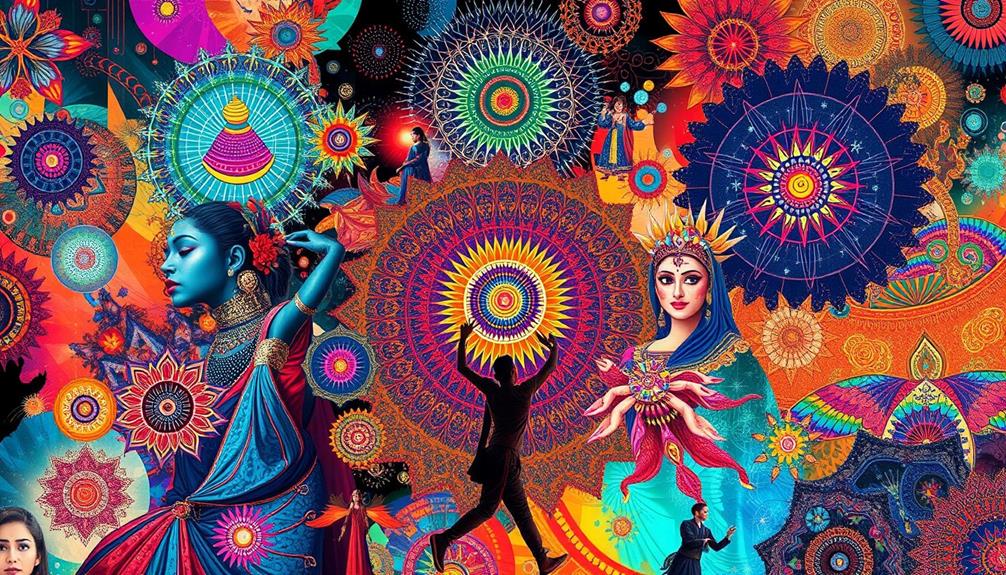
With the rise of digital platforms, artists in India are transforming how they create and showcase their work. Digitisation has opened up new avenues for creativity, allowing you to explore innovative forms like digital art, algorithmic art, and digital collages. This shift not only challenges traditional artistic boundaries but also enhances accessibility and global reach for Indian artists.
As niche marketing strategies continue to yield higher ROI, artists can effectively position themselves within specialized markets.
Social media plays an essential role in your journey as an artist, enabling you to connect with wider audiences and promote your work beyond physical art galleries. The pandemic accelerated this change, proving that online exhibitions and virtual galleries are vital for maintaining cultural discourse and engaging with art lovers.
Emerging art spaces, such as India's first pop art gallery, are incorporating augmented reality and AI technologies, offering you exciting new ways to express your creativity.
These platforms support grassroots talent and reflect the evolving landscape of Indian art. As you embrace these digital transformations, you're not just adapting to change; you're actively shaping the future of art in India, making your mark on a global stage.
Global Influences on Indian Art
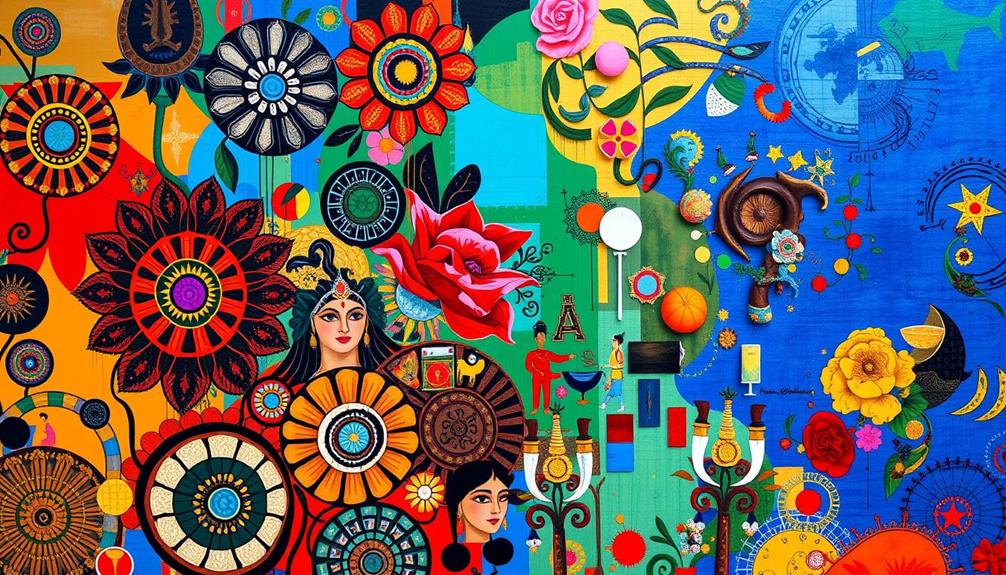
As you explore the global influences on Indian art, you'll notice how cultural exchanges are reshaping traditional practices.
The incorporation of design thinking principles is fostering a more user-centered approach in artistic creation, enabling artists to connect with international trends.
Technology and innovation play an essential role in this transformation, allowing artists to connect with international trends.
International collaborations further enhance this dynamic, creating a vibrant dialogue that enriches the Indian art scene.
Cultural Exchange Dynamics
Cultural exchange enriches the tapestry of Indian art, reflecting a vibrant interplay between local traditions and global influences. You'll find that contemporary Indian artists are harnessing this dynamic, integrating various global art movements into their works. This fusion not only enhances their creativity but also elevates their visibility on international platforms.
For instance, the evolution of celebrity relationships, such as Jennifer Aniston and Brad Pitt's friendship, illustrates how personal dynamics can influence broader cultural narratives.
- The India Art Fair 2023 showcased international galleries, fostering collaboration.
- Digital art initiatives, like augmented reality projects, are reshaping the landscape.
- Social media connects Indian artists with global audiences, broadening their reach.
- Collaborative projects, such as BMW India's art car wrap, blend cultural narratives.
- Global art trends inspire unique techniques in the Indian art scene.
These elements illustrate how cultural exchange is essential for contemporary Indian art. Through collaborative projects and innovative platforms, artists engage in cross-cultural dialogue, expanding their artistic horizons.
Technology and Innovation
Technology and innovation are revolutionizing the Indian art scene, enabling artists to push boundaries and explore new mediums. The integration of digital art forms, like algorithmic art and digital collages, has transformed how you experience and interact with art. These innovative techniques allow artists to reach wider audiences through online platforms, making art more accessible than ever.
Augmented reality (AR) is enhancing viewer engagement, letting you visualize artistic concepts instantly and blurring the lines between physical and digital experiences. At The Designera, India's first pop art gallery, artists embrace augmented reality and artificial intelligence to support emerging talent and foster creative experimentation.
Moreover, digital platforms and social media have accelerated the visibility of Indian artists, facilitating global engagement and collaboration. You can now explore virtual exhibitions and online galleries that showcase diverse artworks from the comfort of your home.
The pandemic has acted as a catalyst for this digitization, pushing galleries and artists to adapt to digital mediums, thereby reshaping traditional art sales and consumption. As a result, the Indian art landscape is evolving, offering you fresh perspectives and experiences through technology and innovation.
International Collaborations Impact
Collaboration is reshaping the landscape of Indian art, infusing it with global perspectives and fresh ideas. As you explore contemporary Indian art, you'll notice how these international ties enhance creativity and broaden narratives.
Here are some key influences:
- Renowned international artists like Anish Kapoor and Rina Banerjee showcased by global galleries.
- Innovative projects like BMW India's "The Future is Born of Art" highlighting modernity and sustainability.
- Cross-cultural dialogue fostered through international participation in art fairs, such as the India Art Fair.
- Digital art initiatives showcasing works from Digital Artists in Residence that integrate global tech advancements.
- Performance pieces, like Debashish Paul's exploration of queer identity, reflecting international socio-political themes.
These collaborations not only elevate the visibility of Indian artists but also enrich the art scene with diverse influences.
You'll find that contemporary Indian art is now a vibrant tapestry woven with threads of global ideas, styles, and issues. As you engage with these works, you'll witness how international partnerships continue to shape the future of art in India.
Emerging Artists and Trends

In the vibrant landscape of contemporary Indian art, a new generation of artists is emerging with a fresh perspective that fuses traditional techniques with modern themes.
These emerging artists are gaining recognition for their innovative practices, creating unique visual narratives that resonate with today's audience. One significant trend is the rise of street art, where vibrant murals and installations are transforming urban spaces while addressing pressing social and political issues.
You'll find that many of these talented individuals are leveraging digital platforms and social media to showcase their work, expanding their reach and connecting with global audiences.
This shift not only democratizes art but also enables artists to engage directly with their followers and collectors.
Moreover, the integration of technology in art creation, such as augmented reality and AI, is becoming prevalent.
This allows you to see artists pushing creative boundaries and experimenting with new mediums.
Collaborative projects and community-focused initiatives are also fostering a supportive environment, encouraging artistic experimentation and cultural exchange.
Future Directions in Indian Art
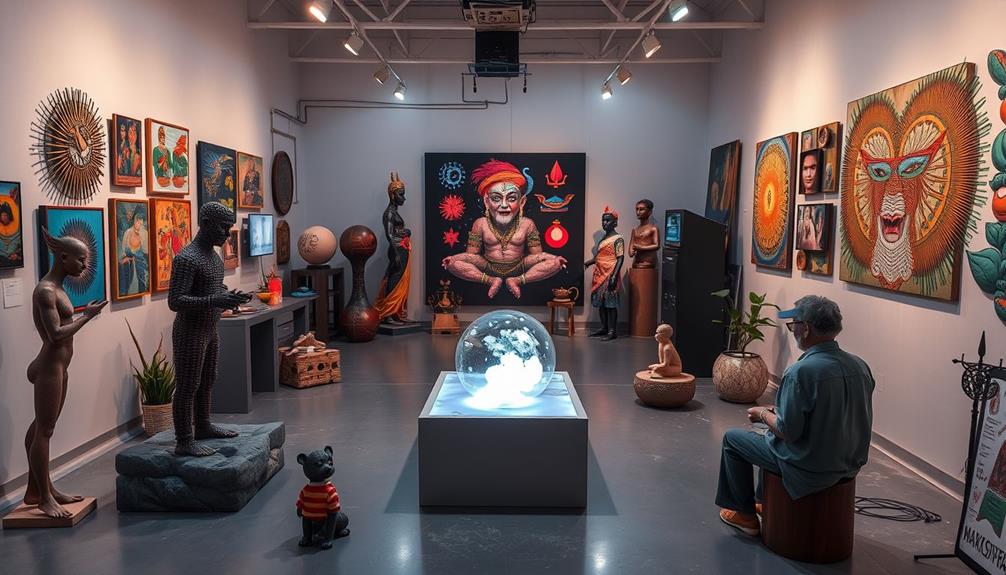
As the Indian art scene evolves, artists are embracing innovative tools and mediums that reshape their creative expressions. The future of Indian art is bright, driven by technology and a shift towards modern practices.
Here's what you can expect:
- Integration of augmented reality to enhance viewer engagement
- Artificial intelligence as a tool for instant concept visualization
- Digital platforms fostering faster art creation and distribution
- Social media providing a global canvas for emerging artists
- Interdisciplinary practices blending traditional techniques with modern concepts
Emerging artists are at the forefront of this transformation, using social media to amplify their voices and tackle contemporary themes.
The pandemic accelerated the adoption of online galleries and virtual exhibitions, making art more accessible than ever.
You'll witness a growing emphasis on interdisciplinary practices, where artists fuse age-old techniques with modern materials, creating dynamic forms that challenge the conventional boundaries of art.
Initiatives like India's first pop art gallery, The Designera, highlight this trend, supporting grassroots talent while integrating technology into art.
The future of Indian art promises to be innovative, diverse, and immensely engaging.
Frequently Asked Questions
What Is Edge of Desire Recent Art in India?
"Edge of Desire" showcases contemporary art in India, exploring themes of desire and identity. You'll see diverse artists using innovative techniques, challenging norms, and sparking discussions about modern social dynamics and individual experiences within society.
What Is the Art Style of India?
Did you know that over 200 distinct art styles exist in India? You'll discover vibrant traditions like Madhubani and Warli, each showcasing unique techniques, narratives, and cultural heritage that enrich the Indian art landscape.
What Are the Main Characteristics of Indian Painting?
Indian painting's main characteristics include intricate details, vibrant colors, and the use of natural materials. You'll find spiritual themes in traditional styles like Madhubani and Kalamkari, reflecting India's diverse cultural narratives and rich heritage.
How Did Indian Art Change After the Indian Independence in 1947?
After Indian Independence in 1947, you'll notice artists blending traditional styles with modern influences, addressing social issues. This shift sparked new movements, encouraging experimentation with techniques and materials, reshaping the landscape of Indian art considerably.
Conclusion
As you explore the vibrant Indian art scene, you'll see how traditional techniques blend seamlessly with modern innovations, creating a dynamic landscape that's nothing short of a creative explosion. The impact of digital transformation and global influences can't be overstated, as emerging artists push boundaries like never before. With each brushstroke and pixel, the future of Indian art promises to be as enchanting as a thousand sunsets, inviting you to witness its evolution firsthand.
Art and Culture
Women as Muses and Artists in Rabindranath Tagore’s Oeuvre
Amidst Rabindranath Tagore’s masterpieces, women emerge as pivotal forces—will their stories redefine the essence of creativity and empowerment in his work?

Women in Rabindranath Tagore's oeuvre are more than muses; they're essential forces that shape his creative journey. Figures like Kadambari Devi and Mrinalini Devi profoundly influenced his emotional landscape, infusing themes of sorrow and memory into his works. Tagore's female characters often challenge societal norms, reflecting empowerment and complex emotional lives. His exploration of women's roles showcases a blend of traditional expectations and the desire for independence, resonating with modern feminist ideals. Each brushstroke and line gives voice to the unseen depths of womanhood, inviting you to explore these intricate dynamics further.
Key Takeaways
- Women in Tagore's life, like Kadambari Devi, profoundly influenced his emotional themes and artistic expression, shaping his poetry and paintings.
- Tagore's exploration of sorrow and memory, often linked to lost relationships, emphasizes the emotional depth women brought to his works.
- His artistic techniques evolved significantly later in life, blending natural elements with expressive forms, reflecting women's complex emotional landscapes.
- Female characters in Tagore's literature challenge societal norms, showcasing empowerment and nuanced portrayal of women's struggles and aspirations.
- Tagore's philosophy positions education as essential for women's empowerment, advocating for their roles as vital contributors to society.
Influence of Women in Tagore's Life
In exploring the influence of women in Rabindranath Tagore's life, you'll find that they weren't just figures in his personal narrative but powerful muses shaping his artistic vision. Kadambari Devi, in particular, played a crucial role in his creative journey, and her emotional complexity can be likened to the depth explored in speech therapy for kids. Her presence inspired many of his poems, as she embodied the complexities of love and loss. The emotional depth he explored in his work often reflected his bond with her.
After Kadambari's tragic suicide in 1884, Tagore faced a profound transformation. This event not only marked a turning point in his emotional life but also influenced the themes he later explored in his poetry. Kadambari's impact remained evident, lingering in his reflections on love, sorrow, and memory.
Mrinalini Devi, his wife, further enriched Tagore's emotional landscape. Her death in 1902 deeply affected him, adding layers to his artistic expression.
Even during his travels, women like Victoria Ocampo inspired him, fostering an international appreciation for his work. Tagore's letters reveal that his emotional connections with women were central to his creativity, highlighting their essential roles as muses and influences in his life.
Themes of Sorrow and Memory

When you explore Tagore's works, you can't help but notice the emotional depth he captures through themes of sorrow and memory.
His art and poetry reflect how memories of lost love and relationships shape his creativity, revealing a raw vulnerability.
This intricate interplay between grief and remembrance not only defines his artistic expression but also enriches your understanding of women as pivotal figures in his life.
Additionally, the influence of astrology and attractiveness may add another layer to how these themes resonate with readers, as personal connections and perceptions can be shaped by cosmic alignments.
Emotional Depth in Art
Emotional depth in art often reveals itself through the intricate interplay of sorrow and memory, a theme that profoundly permeates Rabindranath Tagore's oeuvre. Tagore felt this deeply, as his emotional landscape was shaped by the women in his life, particularly Kadambari Devi. Her haunting presence is evident in his works, like "Portrait of a Woman," where sorrow intertwines with memory.
The themes of love, loss, and grief resonate strongly in pieces such as "First Sorrow," reflecting the profound impact of Kadambari's suicide in 1884. This emotional turmoil can be likened to the experiences of BPD-coded characters, who often navigate intense feelings of love and loss, highlighting the complexities of human relationships exploration of BPD in media.
In his artistic expressions, Tagore employed dark colors and sad expressions, evoking a sense of mourning that showcases his introspective nature. His exploration of women's emotions stands out in works like "Veiled Woman" and "Tableau of Shrouded Women," where the portrayals convey mysterious allure while hinting at deeper themes of sorrow and hidden feelings.
Initiating his artistic journey at age 63, Tagore found a powerful medium for expressing his emotional depth. Through visual art, he bridged the themes of sorrow and memory with the feminine experience, creating a lasting impact that resonates with audiences today.
Memory's Influence on Creativity
Haunting memories often fuel creativity, and in Rabindranath Tagore's work, this influence is strikingly evident. The profound impact of loss resonates deeply in his emotional landscape, particularly with the memory of Kadambari Devi, whose tragic suicide in 1884 left an indelible mark on his themes of sorrow and memory.
This emotional landscape mirrors the complexities seen in narcissistic relationships, where the interplay of personal experiences and emotional turmoil can considerably shape artistic expression. In the poem "First Sorrow," you can feel Tagore's exploration of grief and the haunting echoes of lost love, where melancholic tones capture the essence of his pain.
Tagore's paintings, like "Portrait of a Woman," employ dark colors and sad expressions to evoke mourning, further emphasizing the complex relationship between memory and loss. His artistic techniques, including dense crosshatching and subdued hues, enhance the emotional depth, inviting you to engage with his poignant themes.
Through the interplay of memory and creativity, Tagore vividly depicts women, weaving personal experiences into a rich tapestry of emotional narratives.
In your exploration of Tagore's oeuvre, you'll find that memory serves not just as a backdrop but as a catalyst for creativity, transforming sorrow into profound artistic expression.
Artistic Techniques and Styles
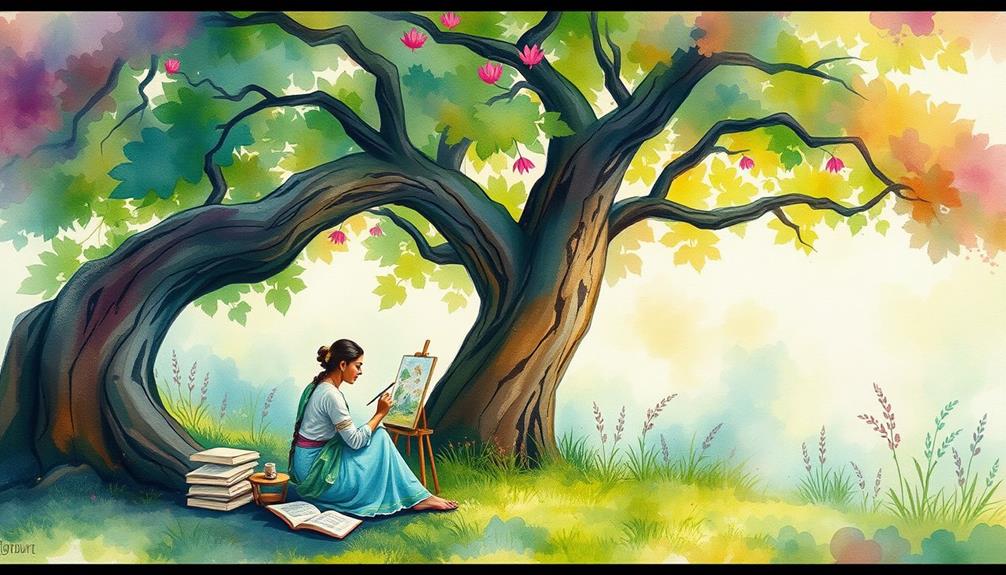
In exploring Tagore's artistic techniques and styles, you'll find a remarkable evolution that reflects his deep emotional insights. Starting his painting journey at the age of 63, he shifted from literature to visual art without formal training. This leap allowed him to express profound emotional themes through his art, similar to how essential oils can enhance mood.
Initially, his works featured simple sketches, but he quickly advanced to complex compositions that often depicted veiled women—symbols of loss and hidden emotions.
Tagore employed dense crosshatching techniques and a subdued color palette, primarily using browns and greys, to enhance the emotional depth of his paintings. His travels to China and Japan in 1924 introduced him to brush and wash techniques, which greatly influenced his artistic development.
This experience contributed to his unique style, blending natural elements with dynamic forms that reflect his connection to landscapes and the inner rhythms of life.
Female Characters in Tagore's Works
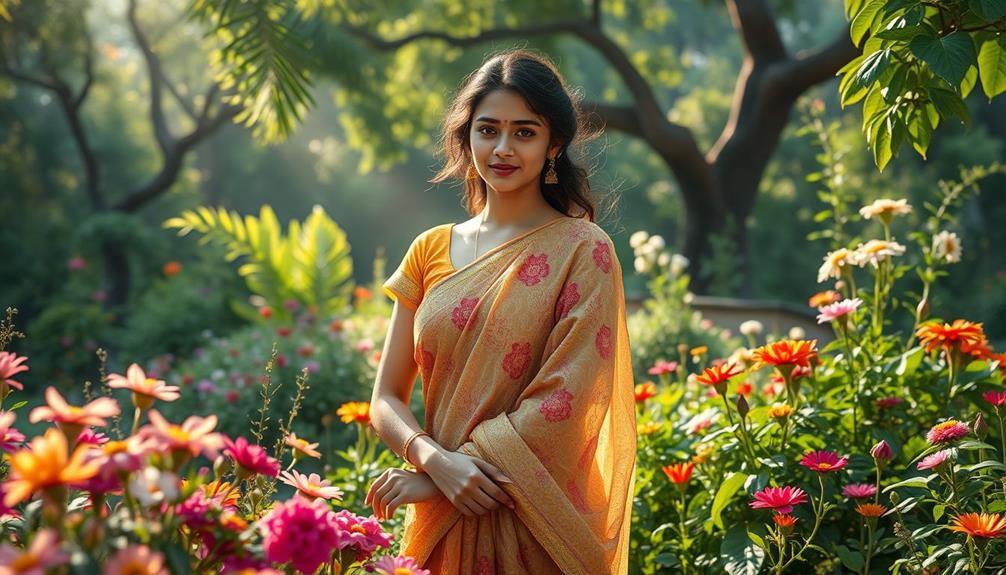
Tagore's artistic journey naturally extended into his literary works, where female characters take center stage and challenge societal expectations of their time. In novels like "Ghaire Baire," Bimala embodies complex emotional landscapes, maneuvering her desires against societal constraints. Similarly, Kamala from "Naukadubi" confronts the norms of her world, illustrating Tagore's nuanced approach to female characters in Tagore's works. His exploration of astrology and attractiveness resonates with the way these characters are perceived within their societal contexts, enhancing their allure and depth.
Tagore also highlights independence and emotional depth through characters like Rajan, the orphan girl from "The Post Master," whose struggles reflect a broader commentary on womanhood. The character of Chitrangada, a Manipuri princess, further represents Tagore's exploration of femininity and empowerment, as she defies traditional narratives and seeks her own identity.
These female characters often grapple with the tension between private and public life, showcasing their pursuit of autonomy within a patriarchal society. By blurring the lines between fiction and visual art, Tagore's paintings frequently feature these characters, reinforcing his thematic focus on women's experiences.
Through his diverse portrayals, you can see how Tagore not only celebrates women but also critiques the limitations imposed on them, making his literary contributions profoundly significant.
Legacy of Women Artists
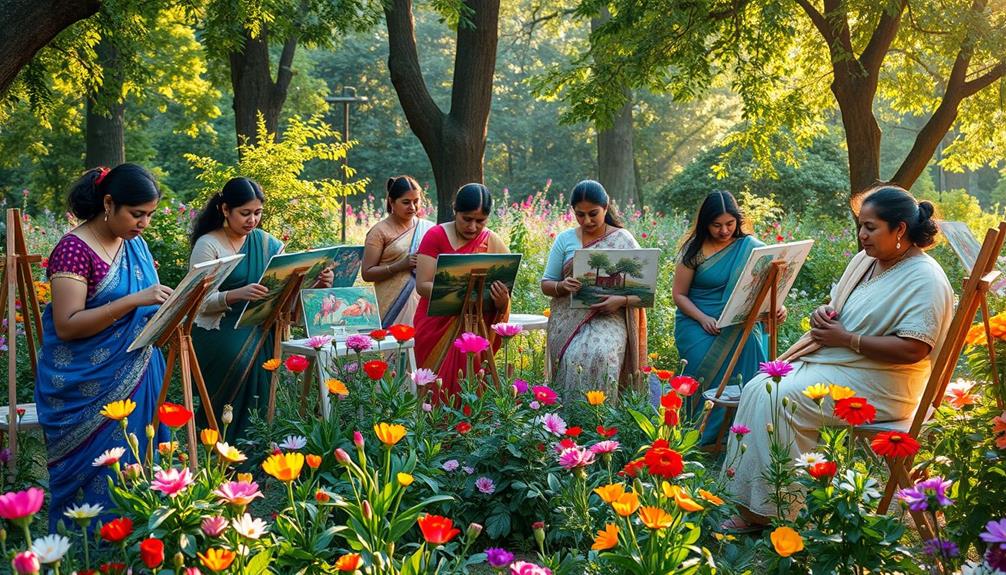
You can't overlook the historical marginalization of women artists, who often faced barriers that silenced their voices despite their immense talent.
Many women throughout history have turned to natural remedies and herbal practices as a form of expression, paralleling their artistic endeavors with holistic health approaches, such as those found in learning resources for herbalism.
Celebrating their contributions is essential for reshaping art history and recognizing the depth of their influence.
Historical Marginalization of Women
Throughout history, countless women artists have faced systemic barriers that have marginalized their contributions to the art world. Despite their mastery, many have remained in the shadows of their male counterparts due to societal norms and sexism. For instance, Sunayani Devi, born into the Tagore family in 1875, created vibrant works that are seldom acknowledged. Similarly, Anna Alma-Tadema, a British artist from 1867, specialized in portraits but struggled for recognition due to institutional sexism.
Here's a snapshot of some notable women artists who illustrate this historical marginalization of women:
| Artist | Contribution |
|---|---|
| Sunayani Devi | Self-taught artist, vibrant painter |
| Anna Alma-Tadema | Portrait specialist, faced rejection |
| Elizabeth Lee Miller | Photographer, documented WWII events |
| Georgia O'Keeffe | Pioneer of modern art, often overlooked |
| Frida Kahlo | Iconic painter, overshadowed by fame |
The ongoing movement for equitable representation emphasizes the importance of recognizing these underappreciated artists. Their contributions are essential to reshaping art history narratives and ensuring that women's voices are finally heard.
Celebrating Female Artistic Contributions
Recognizing the historical marginalization of women in the arts opens the door to celebrating their significant contributions and legacies. Despite their mastery, many women artists like Sunayani Devi have been overlooked, often relegated to obscurity. Born into the Tagore family in 1875, Sunayani was a self-taught artist whose vibrant works deserve more recognition within her family's artistic legacy.
The importance of storytelling in art can echo the powerful narratives shaped by influential figures in society, showcasing how creativity fuels innovation and problem-solving a fundamental aspect of innovation.
Similarly, artists like Anna Alma-Tadema faced rejection from institutions like the National Gallery, despite their exceptional skills. Elizabeth Lee Miller, an American photographer and journalist, documented essential events during WWII, yet her achievements often took a backseat to her relationships with male counterparts. These examples illustrate the systemic barriers women have navigated in the art world.
Today, the movement towards equitable representation is gaining momentum. It's imperative to acknowledge the contributions of underappreciated female artists, not only to honor their legacies but also to inspire future generations.
Tagore's Philosophy on Women

In Tagore's vision, women embody a spiritual essence that's vital to life's journey, serving as essential partners rather than mere subjects of inspiration. He emphasizes the emotional depth and complexity of women, recognizing their unique contributions to society.
Tagore championed women's education as a pathway to empowerment, understanding that knowledge has the transformative power to challenge societal barriers. He believed that an educated woman could redefine her role, asserting her independence and participating actively in the world around her.
Through his literary works, such as "Gitanjali" and "The Home and the World," Tagore highlights women's agency, using female characters to explore their inner lives and confront societal expectations. While some critics argue that he idealized women, his portrayal serves to inspire and elevate their status in society.
His philosophy encourages a deeper understanding of women's roles, advocating for their emotional and intellectual growth. Tagore's influence resonates today, inspiring modern feminist movements that promote gender equality and education initiatives in India.
The Concept of the New Woman
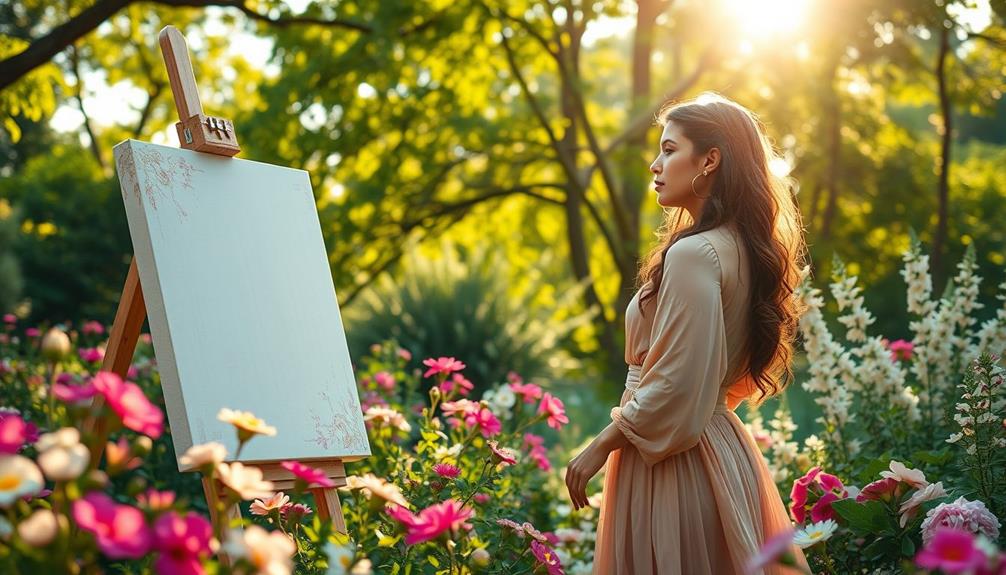
The concept of the "New Woman" emerged as a powerful symbol of change during the late 19th and early 20th centuries, reflecting a growing desire among women for independence, education, and self-assertion. Tagore wrote extensively about this shift, illustrating the evolving roles of women in society. His characters often embody the ideals of the New Woman, showcasing their struggles for identity and recognition within a patriarchal context.
This movement also paralleled a broader understanding of health and well-being, as a holistic lifestyle began to gain importance, emphasizing both physical and emotional health.
In his literature, Tagore emphasizes women's agency and contributions beyond traditional domestic spheres. He believed that educated women could greatly uplift society and challenge outdated norms. His portrayal of women reveals their emotional depth and complexity, highlighting their pursuit of love, freedom, and individuality amid societal constraints.
Through the lens of the New Woman, Tagore explores the personal ambitions of women, allowing them to navigate their desires while confronting societal expectations. By doing so, he advocates for women's education as an essential means of empowerment, ensuring they've the tools to carve their own paths.
In Tagore's works, you can see how the New Woman concept resonates, advocating for a progressive vision of gender roles.
Education and Women's Empowerment

Education serves as a cornerstone for women's empowerment, and Rabindranath Tagore knew this well. He believed that access to education was essential for women to thrive, shaping them into key contributors to society. Tagore's progressive upbringing and exposure to Western feminist movements fueled his advocacy for women's rights, promoting the transformative power of knowledge.
In his literary works, Tagore consistently highlighted women's agency, challenging traditional norms and positioning them as essential partners in life. Let's break down the impact of education on women's empowerment according to Tagore's philosophy:
| Aspect of Education | Impact on Women |
|---|---|
| Access to Knowledge | Enhances decision-making |
| Critical Thinking Skills | Fosters independence |
| Social Awareness | Encourages community engagement |
| Personal Growth | Promotes self-confidence |
Through education, Tagore saw women not just as passive recipients of knowledge but as active participants in crafting a progressive society. By uplifting their voices and individuality, he championed a vision where educated women could redefine their roles in a patriarchal world.
Modern Critiques and Relevance

Throughout the years, Tagore's portrayal of women has sparked both admiration and critique, revealing a complex landscape of gender dynamics. Critics often highlight the idealization in his works, questioning how effective his feminist stance really is today. While his literary representations reflect the contradictions of his personal beliefs, they also underscore the intricate gender roles of his era. This complexity invites modern critiques that seek to reconcile his contributions with contemporary feminist ideals.
Additionally, the exploration of team-based games in social settings mirrors the collaborative themes found in Tagore's narratives, emphasizing the importance of shared experiences in understanding gender dynamics. The Tagore family's influence on Tagore's views is significant; their progressive approach to education and empowerment shaped his understanding of women's agency.
In works like "The Home and the World," he explores evolving gender norms, making his narratives relevant in today's conversations about women's rights. Despite critiques of his perspective on femininity, Tagore's legacy continues to inspire feminist movements in India, prompting necessary dialogues about empowerment.
Ongoing analyses of his contributions emphasize the importance of equitable representation of women in literature and art. They advocate for recognition of under-appreciated female artists, ensuring that their narratives are included in the broader discourse of gender equality. Tagore's work remains a touchstone for these discussions, bridging past and present.
Frequently Asked Questions
Who Was the Muse of Rabindranath Tagore?
Rabindranath Tagore's primary muse was Kadambari Devi. Their deep emotional bond markedly shaped his poetry, with her inspiration evident in his verses. Tragically, her untimely death profoundly impacted Tagore's artistic expression and themes.
What Do You Know About Rabindranath Tagore as a Artist?
Rabindranath Tagore's artistic journey began at 63, producing over two thousand works until 80. His paintings blend traditional Indian styles with European influences, showcasing emotional depth and evoking responses through animated forms and mysterious imagery.
Who Was the Lady With Tagore?
The lady with Tagore often refers to Kadambari Devi, his early muse, who greatly influenced his poetry. Their bond was profound, marked by emotional depth, until her tragic death altered his creative path greatly.
Who Is the Emancipated Women in Rabindranath Tagore's Selected Short Stories?
In Tagore's selected short stories, you'll find emancipated women like Bimala and Charulata. They challenge societal norms, seek personal freedom, and navigate complex emotions, embodying the struggle for self-fulfillment and empowerment in a patriarchal society.
Conclusion
In Tagore's vibrant tapestry, women emerge as both muses and creators, weaving threads of sorrow, strength, and beauty. Their voices echo through his verses, painting a world where the new woman rises like dawn, illuminating paths of empowerment. As you explore his work, let the delicate dance of his female characters inspire you, reminding you that their legacy pulses with relevance today, a timeless melody that calls for celebration and recognition in every heartbeat of art and life.
Art and Culture
The Impact of Fake Art Scams on the Indian Art Market
Fake art scams are undermining India’s art market, leading to financial struggles for artists; discover the urgent measures being proposed to address this crisis.

Fake art scams are wreaking havoc on the Indian art market, costing genuine artists millions each year. With counterfeit works flooding the market, buyers face confusion, driving down prices for authentic pieces. This not only leads to financial insecurity for artists but also threatens cultural integrity. Legislative efforts, like the proposed ARTIST Act, aim to combat these scams and empower enforcement against fraud. Community advocacy is rising as artists unite for transparency and support. The urgency to strengthen regulations is clear, and there's much more happening in this landscape that you might find enlightening.
Key Takeaways
- Counterfeit art scams significantly undermine the economic stability of Indigenous artists, leading to millions in lost income annually.
- The prevalence of fake art creates market confusion, driving down prices for authentic pieces and jeopardizing artists' financial security.
- Legislative reforms, like the proposed ARTIST Act, aim to enhance enforcement against art fraud and protect Indigenous artists' rights.
- Community advocacy and educational initiatives are crucial for raising awareness about counterfeit art and supporting legitimate artists.
- Strengthening legal frameworks and community vigilance is essential for preserving cultural integrity and promoting the value of authentic Native art.
Current State of Fake Art
In recent years, the Indian art market has faced a troubling surge in counterfeit artworks, with estimates suggesting that around 80% of the U.S. market may be flooded with fakes. This alarming situation primarily revolves around fake Native American art, which undermines the authenticity and retail value of genuine pieces created by Native artists.
Investigations have revealed that many counterfeit items originate from manufacturers in the Philippines, with seized jewelry's retail value potentially doubling its declared import value of $11 million. The lack of empathy and understanding regarding the cultural significance of authentic art, similar to the traits of a narcissistic individual, exacerbates the issue, as many fail to recognize the impact on the artists' livelihoods.
The Indian Arts and Crafts Act aims to protect against this deception, but current penalties, including maximum fines of $250,000, are often viewed as inadequate. High-profile legal actions against gallery owners and individuals selling these fraudulent artworks highlight the widespread nature of art fraud and its devastating market impact.
The prevalence of counterfeit goods not only jeopardizes the economic stability of Native artists but also damages the cultural integrity and storytelling aspect inherent in authentic Indigenous art. Addressing this issue is vital for restoring trust and promoting genuine works that reflect the rich heritage of Native communities.
Legislative Measures and Reforms
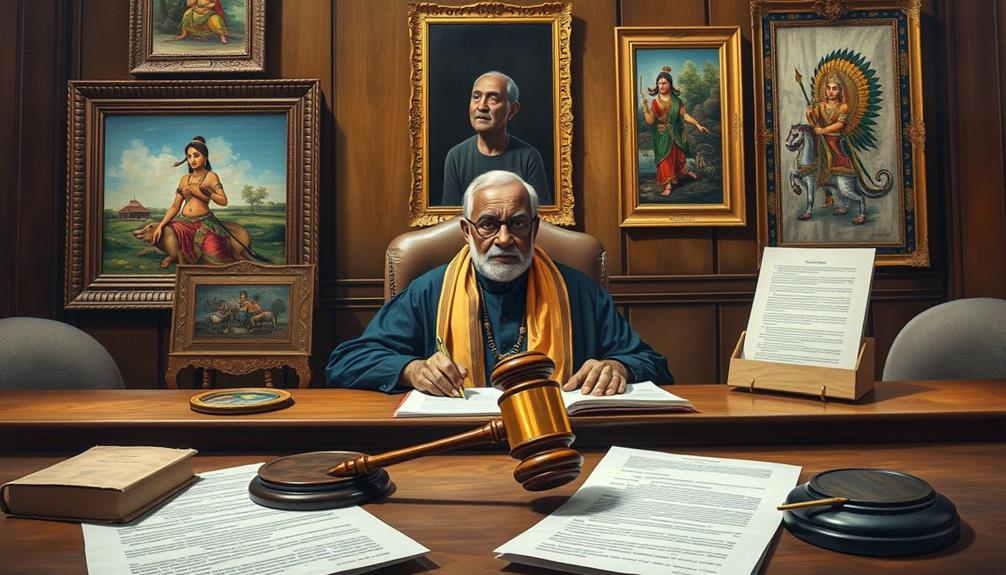
You should know that strengthening the Indian Arts Act is essential in tackling the rise of counterfeit art.
This need for reform is underscored by the increasing incidents of art fraud that undermine the integrity of the art community, as highlighted in discussions about exploring philosophical literature.
The proposed ARTIST Act aims to enhance enforcement mechanisms, giving federal authorities more power to combat art fraud effectively.
As these legislative changes unfold, the focus will be on better protecting Indigenous artists and their authentic works.
Strengthening the Indian Arts Act
Strengthening the Indian Arts Act is vital for protecting the integrity of Native artistic works amidst the rising tide of counterfeit art. The proposed amendments to the Indian Arts and Crafts Act aim to enhance protections for Native American artists, expanding federal enforcement to include Native Hawaiians for the first time.
These updates recognize the sophistication of art fraud, addressing the alarming statistic that around 80% of the U.S. Indian art market is believed to consist of counterfeit goods. Additionally, just as precious metals investments have gained traction due to their security and inflation hedging capabilities, the art market must adapt to safeguard its value and authenticity through legislative measures. The importance of staying informed about these developments is significant for artists and collectors alike.
The ARTIST Act seeks to bolster enforcement mechanisms by granting federal officers new powers for arrests, searches, and seizures related to counterfeit art. By establishing an Indian Arts and Crafts Forfeiture Fund, the Act guarantees that enforcement costs are covered while providing mandatory training for federal law enforcement on relevant legislation.
As the Senate Committee on Indian Affairs reviews these proposed amendments, public comments are accepted until April 14, allowing you to voice your support for tighter regulations.
Strengthening the Indian Arts Act won't only protect Native artistic works but also restore trust in the art market, assuring that genuine creations receive the recognition they deserve.
Enhancing Enforcement Mechanisms
Recent developments highlight the pressing need for enhanced enforcement mechanisms to combat counterfeit Native art effectively. The proposed ARTIST Act aims to bolster federal law enforcement's authority by granting new powers for arrests and searches related to violations of the Indian Arts and Crafts Act.
This reform is vital for conducting thorough investigations into sophisticated counterfeit operations that plague the market, much like the benefits of diversifying investments in a volatile economic environment.
To guarantee robust enforcement, the establishment of the Indian Arts and Crafts Forfeiture Fund will provide essential resources for costs associated with these efforts. Additionally, the ongoing training of federal officers on relevant legislation will improve their capacity to identify and prosecute violations, thereby boosting accountability.
Recent Senate Committee amendments focus on strengthening authenticity requirements in Indigenous art production and increasing penalties for those who violate these laws. Current penalties, including fines up to $250,000, are seen as inadequate by officials who recognize the need for more severe consequences to deter counterfeiters.
Economic Consequences for Artists

When counterfeit art floods the market, you face lost income opportunities that can cripple your financial stability.
The erosion of market value for authentic pieces means you struggle to earn a fair price for your work. This situation not only affects your livelihood but also threatens the cultural heritage you represent.
Additionally, the psychological effects of such scams can lead to feelings of loss and anxiety among artists, as they grapple with the impact on their creative expression and professional identity, similar to how individuals cope with emotional recovery strategies during challenging times.
Lost Income Opportunities
The impact of fake art scams on Indigenous artists is staggering, with estimates suggesting millions lost annually due to counterfeit items. In the Indian art market, up to 80% of what's available might be fake, severely limiting sales opportunities for genuine Native artists.
This saturation of counterfeit art not only confuses buyers but also drives down prices for authentic pieces, much like how the prevalence of counterfeit goods affects the value of unique home decor items in the Modern Farmhouse Decor Trends. As a result, you may find it increasingly difficult to get the income you deserve for your work.
Many artists report feeling pressured to abandon their crafts, as financial insecurity looms large due to art fraud. The presence of counterfeit items can create an environment where your talent and hard work go undervalued.
With legitimate sales opportunities dwindling, your income potential shrinks considerably. Federal law enforcement is aware of these issues and is investigating counterfeit networks.
They've discovered that the retail value of seized fake jewelry often doubles the declared value, highlighting the substantial loss for authentic artists like you. This situation not only affects your income but also threatens the cultural heritage that your art represents, emphasizing the urgent need to tackle this issue head-on.
Market Value Erosion
Counterfeit art isn't just a nuisance; it's actively eroding the market value of genuine Indigenous art. As a result, Native artists face significant challenges in maintaining their economic stability. The prevalence of counterfeit goods—estimated to make up 80% of the U.S. Indian art market—leads to substantial revenue loss for authentic creators. This art fraud creates market saturation, forcing many legitimate artists to abandon their crafts due to financial instability.
| Issue | Impact on Artists | Overall Consequence |
|---|---|---|
| Market Value Erosion | Decline in art prices | Reduced income and prestige |
| Counterfeit Art | Increased competition | Loss of authenticity |
| Revenue Loss | Inability to sustain practice | Diminished cultural heritage |
| Financial Instability | Struggles to sell art | Artist exodus from market |
| Market Saturation | Overwhelmed by fakes | Erosion of community support |
The combined effects of these issues threaten the integrity of the Indian art market. As you witness these changes, remember that supporting genuine artists is crucial for preserving their craft and ensuring the future of Native art.
Community Response and Activism

Many artists and community organizations are taking a stand against the rise of fake art scams in the Indian art market. Their efforts focus on preserving authenticity and protecting Indigenous artistic integrity.
Reviving old friendships can be an example of how community bonds strengthen as they endeavor to support genuine artists. Here are three key strategies they employ:
- Advocating for stricter regulations: Community organizations push for legal frameworks that combat counterfeit Native art, guaranteeing that authentic artists receive the recognition and profits they deserve.
- Raising awareness at local events: Platforms like Santa Fe's summer Indian Market highlight legitimate Indigenous artists, fostering community support while exposing fraud in the art market.
- Promoting transparency and accountability: Social media backlash against misrepresentation has sparked demands for clear funding and affiliation disclosures, emphasizing the importance of vigilance against fraudulent claims.
Grassroots movements unite Indigenous artists, urging government intervention to protect their work and guarantee profits return to their communities.
By collectively advocating for these initiatives, they not only address the immediate threat of counterfeit art but also build a more resilient and transparent art community.
Together, they're endeavoring to uphold the value of authentic artistry and defend against the pervasive fraud that threatens their cultural heritage.
Educational Initiatives for Awareness
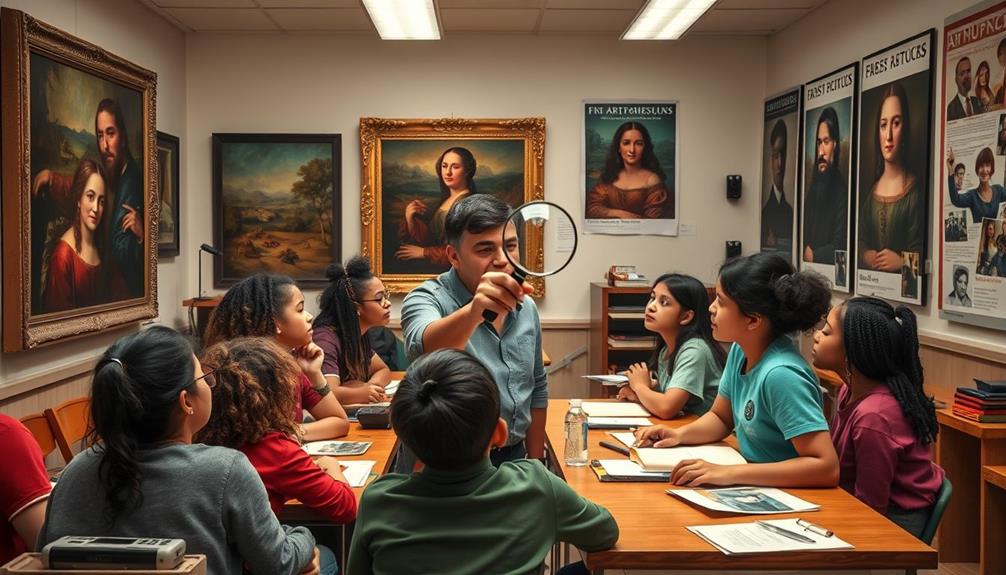
Community activism lays a solid foundation for educational initiatives aimed at raising awareness about fake art scams in the Indian art market. By collaborating with online platforms, the Indian Arts and Crafts Board conducts workshops and seminars, especially during events like Santa Fe's summer Indian Market.
These educational initiatives focus on the importance of authenticity in Indigenous art, equipping buyers with the knowledge to identify counterfeit Native art and understand the implications of purchasing fraud. Additionally, fostering social connections within the community can help amplify the message of authenticity in art, creating a support network that encourages informed purchasing decisions.
Utilizing technology for awareness campaigns can also enhance outreach efforts, ensuring a broader audience is engaged in discussions about caregiver support resources.
The Indian Arts and Crafts Act plays a significant role in ensuring sellers provide accurate information about the origin and authenticity of their items.
Educational efforts emphasize compliance from galleries and retailers while raising awareness about the economic impact of counterfeit art on legitimate Indigenous artists. Community outreach programs and social media campaigns further amplify this message, highlighting the cultural significance of authentic Indigenous work.
Future Challenges and Opportunities
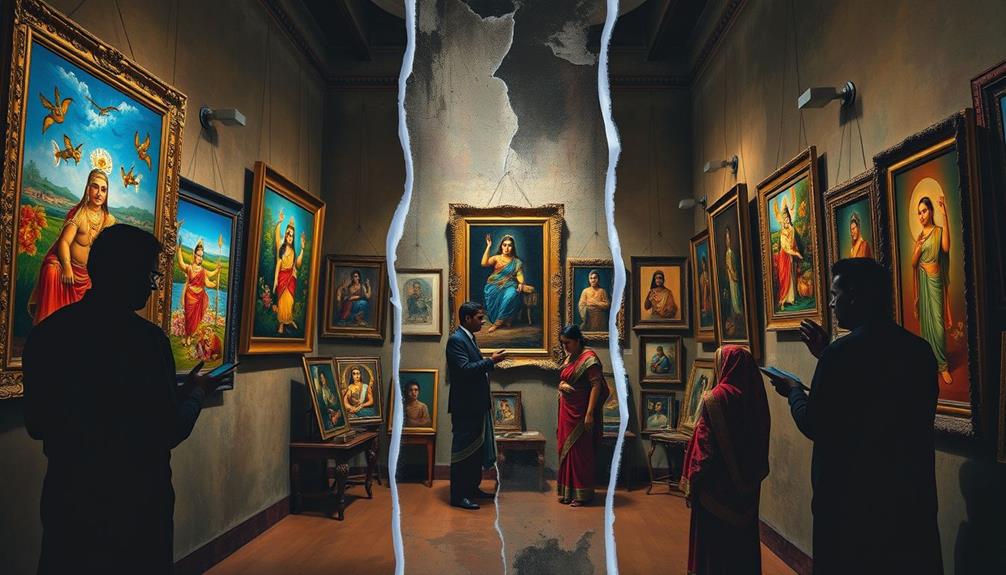
The Indian art market stands at a crossroads, facing both significant challenges and promising opportunities as it grapples with the pervasive issue of counterfeit art. To navigate this landscape, consider these key factors:
- The need for stronger legal frameworks to combat art fraud.
- The importance of community vigilance in preserving cultural integrity. Additionally, implementing thorough best practices for employee background checks could help foster a more secure environment within the art community.
- The potential for educational initiatives to promote authentic Native art.
With up to 80% of the market possibly made up of counterfeit items, the economic viability for Indigenous artists is at stake. Legislative efforts like the proposed ARTIST Act aim to address this crisis by modernizing protections and expanding enforcement mechanisms against sophisticated international counterfeiting operations.
However, the existing penalties under the Indian Arts and Crafts Act remain insufficient to deter counterfeiters effectively.
Emerging from these challenges are opportunities for a sustainable market, driven by community support and awareness. By investing in educational initiatives, you can help raise awareness about the significance of purchasing authentic Native art.
This collective effort can foster a thriving art ecosystem, ensuring that Indigenous craftsmanship is honored and preserved for future generations.
Frequently Asked Questions
What Impact Does the Production of Fake Art Have on Indigenous Artists?
When you consider the production of fake art, it directly undermines Indigenous artists. You'll notice their livelihoods suffer, as these counterfeits flood the market, making it hard for genuine creators to thrive and maintain their cultural heritage.
What Is Indian Art Influenced By?
Indian art's a vibrant tapestry woven from diverse cultural threads, influenced by Indigenous traditions, spiritual beliefs, and historical narratives. You'll find it reflects unique identities while embracing modern themes that resonate with contemporary experiences.
Is It a Crime to Sell Fake Art?
Yes, it's a crime to sell fake art. Misrepresenting artwork as authentic can lead to serious legal consequences, including hefty fines and imprisonment. Always verify authenticity to protect yourself and support genuine artists.
Is There a Market for Native American Art?
You might think there's a thriving market for Native American art, and you're right! But beware—knowing the difference between authentic pieces and counterfeits is essential to truly appreciating and supporting Indigenous artists.
Conclusion
As you navigate the vibrant corridors of the Indian art market, remember: the shadow of fake art scams looms large. Artists struggle, and the integrity of creativity hangs by a thread. Will you stand by as these scams erode the very essence of art? Or will you take action, joining the fight for authenticity? Your awareness could spark change, ushering in a future where true talent shines bright, free from deception. The choice is yours—what will you do?
-

 Art and Culture3 months ago
Art and Culture3 months agoTyeb Mehta's Mind-Blowing Paintings Will Shake You
-
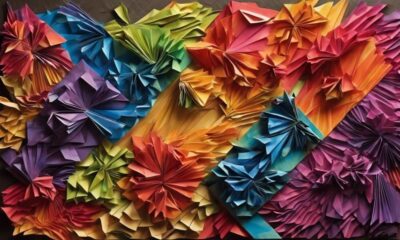
 Art and Culture3 months ago
Art and Culture3 months agoThe Artist's Philosophy That Will Change How You See Art
-

 Art and Culture3 months ago
Art and Culture3 months agoMeet India's Rebel Street Artist You Need To Know
-

 Art and Culture3 months ago
Art and Culture3 months agoRabindranath Tagore's Paintings of Women That Will Captivate You
-

 Art and Culture3 months ago
Art and Culture3 months agoThe Bizarre Art Movement Inspired By Arabian Nights
-

 Art and Culture2 months ago
Art and Culture2 months agoAbstract Art That Will Bend Your Perception
-

 Art and Culture2 months ago
Art and Culture2 months agoMeet The Rebel Artist Taking Public Art To New Heights
-

 Art and Culture2 months ago
Art and Culture2 months agoThis Artist's Journey Through Time Will Captivate You













